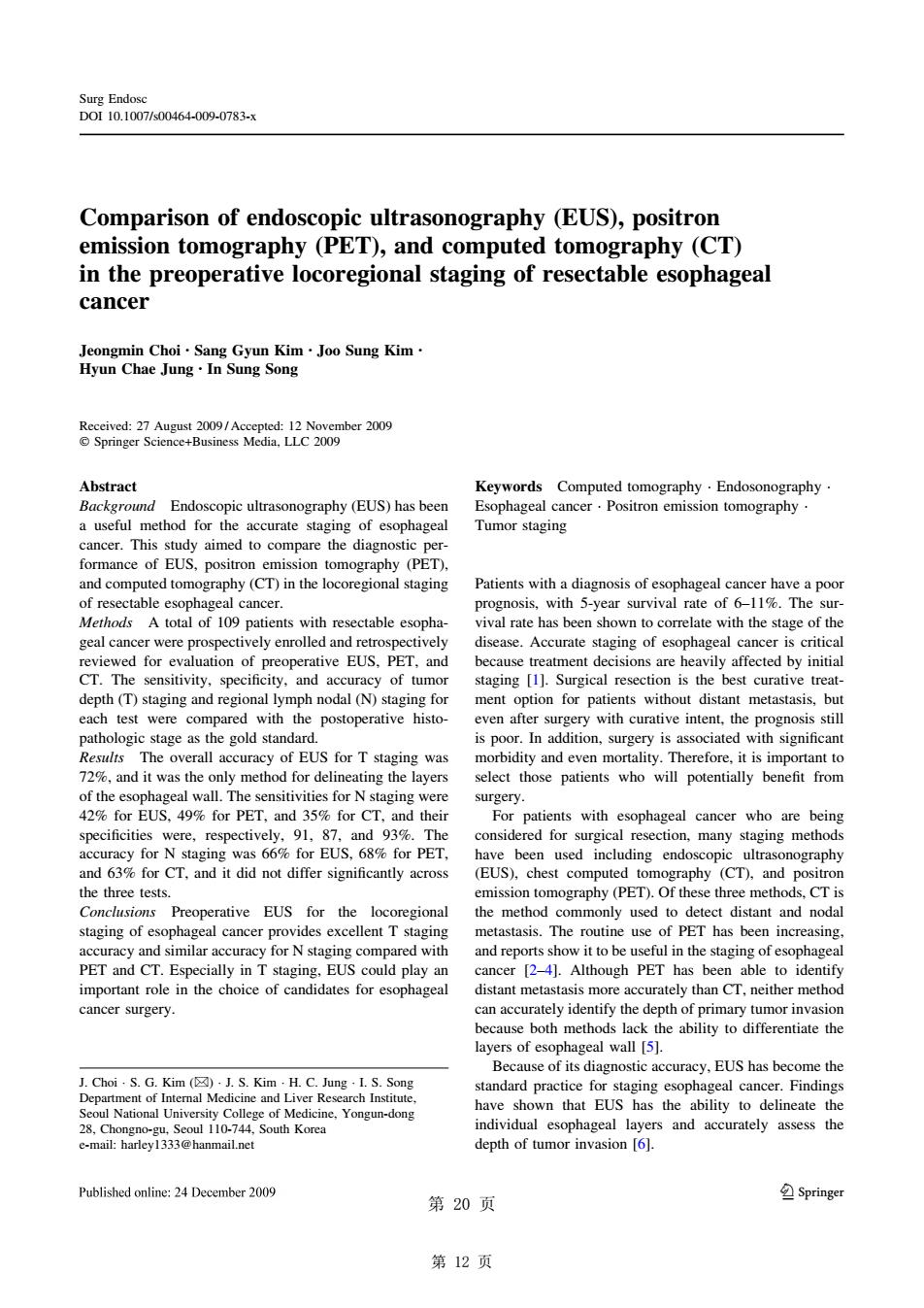正在加载图片...

/00464-009-0783- Comparison of endoscopic ultrasonography (EUS),positron emission tomography (PET),and computed tomography (CT) in the preoperative locoregional staging of resectable esophageal cancer Hyun Chac Jung Sang Kim Abstract Keywords Computed tomographyEndosonography formance of EUS.positron I staging Patients with a diag sis of Med total of 109 patients with resectable esopha geal cancer were prospectively enrolled and re disease.Accurate staging of esophageal cancer is critica depth (T)staging and regional lymph nodal (N)s taging for ment option for patients without distant metastasis,bu were compare postoperative histo of EUS for T stagir tant to it was the ony method for delineatinghe layers select those patients who will potentially benefit from surgery. specificities 91 87 and 936 The racy for N staging was 66%for EUS,68%for PET, been used including endos for CT,and it did not differ significantly acre (EUS chest comp aphy Conclusions Preoperative EUS for the locor the method commonly used to detect distant and nodal staging of esophageal cancer provides excellent Tstaging metastasis.The routine use of PET has been increasing nyfor N sta nd rep important role in the choice of candidates for eso distant met stasis more accurately than cr neither methoc cancer surgery. naccurately identify the depth of primarytumor invasio erentiate the Because of its diagnostic accuracy.EUS has become the H. ne.Y s the uth Korea ndivid that e-mail:harley133 depth of tumor invasion 6). 第20页 Springe 第12页Comparison of endoscopic ultrasonography (EUS), positron emission tomography (PET), and computed tomography (CT) in the preoperative locoregional staging of resectable esophageal cancer Jeongmin Choi • Sang Gyun Kim • Joo Sung Kim • Hyun Chae Jung • In Sung Song Received: 27 August 2009 / Accepted: 12 November 2009 Springer Science+Business Media, LLC 2009 Abstract Background Endoscopic ultrasonography (EUS) has been a useful method for the accurate staging of esophageal cancer. This study aimed to compare the diagnostic performance of EUS, positron emission tomography (PET), and computed tomography (CT) in the locoregional staging of resectable esophageal cancer. Methods A total of 109 patients with resectable esophageal cancer were prospectively enrolled and retrospectively reviewed for evaluation of preoperative EUS, PET, and CT. The sensitivity, specificity, and accuracy of tumor depth (T) staging and regional lymph nodal (N) staging for each test were compared with the postoperative histopathologic stage as the gold standard. Results The overall accuracy of EUS for T staging was 72%, and it was the only method for delineating the layers of the esophageal wall. The sensitivities for N staging were 42% for EUS, 49% for PET, and 35% for CT, and their specificities were, respectively, 91, 87, and 93%. The accuracy for N staging was 66% for EUS, 68% for PET, and 63% for CT, and it did not differ significantly across the three tests. Conclusions Preoperative EUS for the locoregional staging of esophageal cancer provides excellent T staging accuracy and similar accuracy for N staging compared with PET and CT. Especially in T staging, EUS could play an important role in the choice of candidates for esophageal cancer surgery. Keywords Computed tomography Endosonography Esophageal cancer Positron emission tomography Tumor staging Patients with a diagnosis of esophageal cancer have a poor prognosis, with 5-year survival rate of 6–11%. The survival rate has been shown to correlate with the stage of the disease. Accurate staging of esophageal cancer is critical because treatment decisions are heavily affected by initial staging [1]. Surgical resection is the best curative treatment option for patients without distant metastasis, but even after surgery with curative intent, the prognosis still is poor. In addition, surgery is associated with significant morbidity and even mortality. Therefore, it is important to select those patients who will potentially benefit from surgery. For patients with esophageal cancer who are being considered for surgical resection, many staging methods have been used including endoscopic ultrasonography (EUS), chest computed tomography (CT), and positron emission tomography (PET). Of these three methods, CT is the method commonly used to detect distant and nodal metastasis. The routine use of PET has been increasing, and reports show it to be useful in the staging of esophageal cancer [2–4]. Although PET has been able to identify distant metastasis more accurately than CT, neither method can accurately identify the depth of primary tumor invasion because both methods lack the ability to differentiate the layers of esophageal wall [5]. Because of its diagnostic accuracy, EUS has become the standard practice for staging esophageal cancer. Findings have shown that EUS has the ability to delineate the individual esophageal layers and accurately assess the depth of tumor invasion [6]. J. Choi S. G. Kim (&) J. S. Kim H. C. Jung I. S. Song Department of Internal Medicine and Liver Research Institute, Seoul National University College of Medicine, Yongun-dong 28, Chongno-gu, Seoul 110-744, South Korea e-mail: harley1333@hanmail.net 123 Surg Endosc DOI 10.1007/s00464-009-0783-x 义 第 12 页�����������